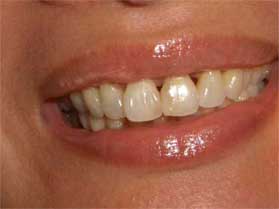|
Crowns |
 |
 |
|
Crowns
A crown is a covering that encases the entire tooth surface restoring it to its original shape and size. A crown protects and strengthens tooth structure that cannot be restored with fillings or other types of restorations. Although there are several types of crowns, porcelain (tooth colored crown) are the most popular. They are highly durable and will last many years, but like most dental restorations, they may eventually need to be replaced. Porcelain crowns are made to match the shape, size, and color or your teeth giving you a natural, long-lasting beautiful smile. Reasons for crowns:
What does getting a crown involve? A crown procedure usually requires two appointments. Your first appointment will include taking several highly accurate molds (or impressions) that will be used to create your custom crown. A mold will also be used to create a temporary crown which will stay on your tooth for approximately two weeks until your new crown is fabricated by a dental laboratory. While the tooth is numb, the dentist will prepare the tooth by removing any decay and shaping the surface to properly fit the crown. Once these details are accomplished, your temporary crown will be placed with temporary cement and your bite will be checked to ensure you are biting properly. At your second appointment your temporary crown will be removed, the tooth will be cleaned, and your new crown will be carefully placed to ensure the spacing and bite are accurate.
Fixed Bridges
A dental bridge is a fixed (non-removable) appliance and is an excellent way to replace missing teeth. There are several types of bridges. You and your dentist will discuss the best options for your particular case. The "traditional bridge" is the most popular type and is usually made of porcelain fused to metal. This type of bridge consists to two crowns that go over two anchoring teeth (abutment teeth) and are attached to pontics (artificial teeth), filling the gap created by one or more missing teeth. Dental bridges are highly durable and will last many years, however they may need replacement or need to be re-cemented due to normal wear. Reasons for a fixed bridge:
What does getting a fixed bridge involve? Getting a bridge usually requires three visits. While the teeth are numb, the two anchoring teeth are prepared by removing a portion of enamel to allow for a crown or decay removed and a build up material palced. Next, a highly accurate impression (mold) is made which will be sent to a dental laboratory where the bridge will be fabricated. In addition, a temporary bridge will be made and worn for three weeks until your final appointment. At the second visit, your temorary will be removed, and the metal coping from the labratory will be carefully placed onto your teeth. At this time, your dentist will carefully check all fittings and size to make sure that the bridge will fit properly. Your temporary will then be placed back on and the bridge will be sent back to the labratory for the final finish. At the Final visit, you permanent bridge will be carefully checked, adjusted, and cemented to achieve a proper fit. Occasionally your dentist may only temporarily cement the bridge, allowing your teeth and tissue time to get used to the new bridge. The new bridge will be permanently cemented at a later time.
|






